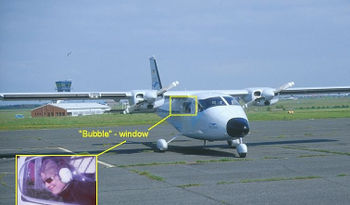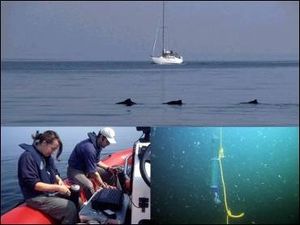Acoustic monitoring of marine mammals
This article explains how we can monitor marine mammals by acoustic methods. This article provides an example of remote sensing by airplane and of the application of acoustic underwater methods.
Contents
Introduction
Marine mammals, especially members of the two orders Pinnipedia (seals) and Cetacea (whales), have evolved an acute sense of hearing as well as the ability to use sound for communication purposes. Moreover, numerous species of toothed whales are capable of using echolocation to detect and characterize their food, to navigate underwater and to avoid obstacles. The transmission of sound is the most efficient form of underwater information transfer not only for the animals to communicate and orient themselves in their submarine environment, but also for researchers to detect and localize the animals through active and passive acoustic detection methods. The acoustic characteristics of sound emissions of marine mammals can differ considerably, ranging from very short pulsed echolocation clicks to long-lasting frequency modulated songs. Due to their mainly submerged lifestyle, it is difficult to assess the movements and habitat uses of whales and seals. To monitor their movements as well as their abundance and density in selected areas over time, it is important to choose the appropriate methods.
Monitoring of marine mammals
The abundance and distribution of marine mammals can best be assessed by line transect distance sampling methods and corresponding analyses techniques. Data can be gathered from by visual observation above the surface (land-based from an elevated point on the shore, ship-based or from an aircraft) or by using passive hydro-acoustic detectors.
Hydrophones allow detection of sounds emitted underwater by the marine mammals (e.g. [1]). The sensitivity of these acoustic receivers and the bandwidth of the hydrophones' frequency spectrum in relation to the ambient noise, define the detection range of the hydrophones and hence the variety of marine mammals it can detect. The receiving hydrophones are either being towed behind a vessel ([2]) or deployed as stationary hydrophones (SOSUS [3], T-PODs ([4]. When towed, usually two or more hydrophones are installed in an array. The time difference of arrival of the animals' individual sounds at the spatially separated hydrophones allows to triangulate and analyse a bearing of the received sound, thereby locating its sound source. Usually special sound recognition software is needed to identify the species to which the recorded sounds can be attributed to.
With decreasing the size of the technical acoustic components, it is possible to deploy sound recording systems on marine mammals in order to monitor their acoustic emissions simultaneously to sound emissions received by them. In combination with satellite transmitters and archival data loggers (D-tag [5], A-tag, this new approach allows one to follow the animals' movements and to analyse their behaviour in relation to environmental parameters in retrospect due to dead reckoning methods.
See also
Internal links
- General principles of optical and acoustical instruments
- Currents and turbulence by acoustic methods
- Acoustic backscatter profiling sensors (ABS)
- Acoustic point sensors (ASTM, UHCM, ADV)
- Marine mammals' health as an indicator of ecosystem health - tools for monitoring
- Counting seabirds from ships and aircraft
- Application of data loggers to seabirds
Further reading
- Monitoring: G.W. GARNER, S.C. AMSTRUP, J.L. LAAKE, B.F.J. MANLY, L.L. MCDONALD & D.G. ROBERTSON (Eds.) (1999): Marine Mammal Survey and Assessment Methods. A.A.Balkema, Rotterdam and Brookfield.
- Distance Sampling: S.T. BUCKLAND, D.R. ANDERSON, K.P. BURNHAM, J.L. LAAKE, D.L. BORCHERS & L. THOMAS (2001). Introduction to Distance Sampling: Estimating abundance of Biological Populations. Oxford University Press, Oxford, UK.
- Marine Mammal Ecology: J.E. Reynolds, III. & S.A. Rommel (Eds.) (1999). Biology of Marine Mammals. Smithsonian Institution Press, Washington and London.
- Marine Mammal Acoustics: W.J. RICHARDSON, C.R. JR GREENE, C.I. MALME & D.H. THOMSON (1995). Marine Mammals and Noise. London: Academic Press.
References
Please note that others may also have edited the contents of this article.
|

